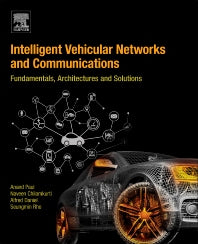Freshly Printed - allow 10 days lead
Couldn't load pickup availability
Intelligent Vehicular Networks and Communications
Fundamentals, Architectures and Solutions
Examines cognitive radio, big data, and the cloud in vehicular communications and the current and future evolution of today's transportation system
Anand Paul (Author), Naveen Chilamkurti (Author), Alfred Daniel (Author), Seungmin Rho (Author)
9780128092668, Elsevier Science
Paperback, published 5 September 2016
242 pages
23.4 x 19 x 1.6 cm, 0.63 kg
Intelligent Vehicular Network and Communications: Fundamentals, Architectures and Solutions begins with discussions on how the transportation system has transformed into today’s Intelligent Transportation System (ITS). It explores the design goals, challenges, and frameworks for modeling an ITS network, discussing vehicular network model technologies, mobility management architectures, and routing mechanisms and protocols. It looks at the Internet of Vehicles, the vehicular cloud, and vehicular network security and privacy issues. The book investigates cooperative vehicular systems, a promising solution for addressing current and future traffic safety needs, also exploring cooperative cognitive intelligence, with special attention to spectral efficiency, spectral scarcity, and high mobility. In addition, users will find a thorough examination of experimental work in such areas as Controller Area Network protocol and working function of On Board Unit, as well as working principles of roadside unit and other infrastructural nodes. Finally, the book examines big data in vehicular networks, exploring various business models, application scenarios, and real-time analytics, concluding with a look at autonomous vehicles.
Chapter 1: Introduction: intelligent vehicular communications Chapter 2: Intelligent transportation systems Chapter 3: Vehicular network (VN) model Chapter 4: Evaluation of vehicular network models Chapter 5: Cognitive radio in vehicular network Chapter 6: Theory and application of vehicular networks Chapter 7: Vehicular network as business model in Big Data Chapter 8: Big Data collision analysis framework Chapter 9: Future trends and challenges in ITS
Subject Areas: Transport: general interest [WG], Computer networking & communications [UT], Enterprise software [UFL], Medical bioinformatics [MBF]


